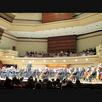Chicago Symphony Orchestra presented Overture
- Natalia Dagenhart
- Jun 14, 2021
- 4 min read
Updated: Jun 16, 2021

On this photo: Musicians of the CSO perform on stage in Orchestra Hall under the baton of Maestro de Waart. Photo by: Anne Ryan.
“If only the whole world could feel the power of harmony,” said Wolfgang Amadeus Mozart. I am not sure about the entire world, but those who chose to attend the Chicago Symphony Orchestra’s Overture concert program definitely felt the power of harmony and enjoyed the beauty of classical music. Overture is the orchestra’s third live concert program this season. It took place June 10, 11, 12, and 13 at the Chicago Symphony Center.
The audience members felt calm and confident attending these concerts as new “Safe and Sound” measures have been adopted to welcome patrons back to Symphony Center. At all times, patrons and staff are required to follow all the necessary safety measures such as wearing face coverings and observing social distancing guidelines when inside the Symphony Center.
This concert program, as well as the first two live concert programs (Fanfare and Strum), was presented for reduced-capacity audiences in Orchestra Hall with safety measures in place in accordance with current state and city COVID-19 guidelines for public events.
It’s important to note that the Chicago Symphony Orchestra performed live for its audiences presenting these three distinct concert programs for the first time since March 2020. Overture is the final concert program of this short series of live concerts.

On this photo: Edo de Waart leads the Musicians of the Chicago Symphony Orchestra. Photo by: Anne Ryan.
Under the baton of Maestro Edo de Waart, this concert program sounded particularly superb. The extensive career of this brilliant conductor and his outstanding experience and achievements helped to demonstrate the best qualifications of the Chicago Symphony Orchestra musicians.
Originally from the Netherlands, Edo de Waart began his career as an assistant conductor to Leonard Bernstein at the New York Philharmonic. Since then, he gained international recognition for his mastership and talent. In the 2019-2020 season, Maestro de Waart began his role as principal guest conductor of the San Diego Symphony Orchestra. He is conductor laureate of the New Zealand Symphony Orchestra, Antwerp Symphony Orchestra and Netherlands Radio Philharmonic Orchestra. De Waart is music director laureate of the Milwaukee Symphony Orchestra. Maestro de Waart is also known as an acclaimed opera conductor.
The program started with Overture to Don Giovanni written by Wolfgang Amadeus Mozart. He wrote his 2 act opera Don Giovanni in 1787, however it is said the overture was composed the night before the opera’s premiere. Needless to say, the proximity of the writing of this composition didn’t reflect on the quality of this amazing piece.
This famous and intriguing overture is written in the classic three section sonata form structure and contains no themes from the opera itself. Although it carries a tense and somewhat dark mood, the audience appreciated the various groups of instruments of the orchestra performing in a beautiful ensemble and their ability to demonstrate the dramatism of the music and its development. I have to tell you, every musician should know how to play Mozart just as the Chicago Symphony Orchestra musicians do, as they are really good at showing the composer’s real intentions and demonstrating the beauty of his compositions.

On this photo: Concertmaster Robert Chen and the violin section of the Chicago Symphony Orchestra. Photo by: Anne Ryan.
This overture was followed by a picturesque composition called Siegfried Idyll by German composer Richard Wagner, which he devoted to his wife Cosima and their son. This calm and peaceful piece impressed the audience by its eloquent main melody that kept developing dynamically and emotionally. It was picked up by various groups of instruments creating an unforgettable musical dialog.
You could hear that the musicians were playing from their heart. This piece was thoughtful, but not sad, and impressed the audience with its rich sound. I was watching the hands of the conductor - his movements were smooth and precise at the same time.
The sounds of one of the most recognizable masterpieces written by Mozart, Symphony No. 40, concluded this concert program. When the orchestra started playing this piece, I had goosebumps. I have to admit, it’s one of my favorite compositions. The symphony’s first part, Molto Allegro, is extremely popular, and even if a person doesn’t remember the name and the author of it, they definitely heard it at least once in their life. Its expressive melody is catching and intriguing, yet easy to understand and memorize. The composer’s musical thought is straightforward and absolute - by its structure and emotional fullness I can definitely call it perfect.

On this photo: Principal Timpanist David Herbert. Tage Larsen, trumpet. Photo by: Anne Ryan.
The second part of the symphony, Andante, is also very popular. Its beautiful, thoughtful melody impressed everyone with its inner development and elegance. The third part, Menuetto: Allegretto demonstrated the composer’s ability to create precise musical phrases while demonstrating their expressiveness, yet showing the instruments’ calm and confident dialog.
The final part of this symphony, Allegro Assai, brought a lot of emotion and energy. Its playful and elegant melody is also very popular. Its inner power and an impressive musical dialog between the instruments touched everyone’s heart. What did I feel at that moment? I realized that this world will keep rotating while the music of Mozart is alive.
This concert program didn’t just bring the Chicago Symphony Orchestra’s 2020/21 season to a fitting close. It also became an overture to its bright and successful future concerts and performances, as these long and difficult months of pandemic showed us how much we need live classical music events in our lives.
Natalia Dagenhart
6/14/21
This article can also be found here:

























Comments